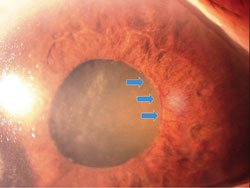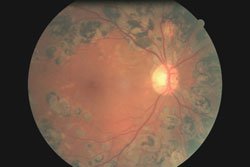Cataract surgery in diabetic patients poses more challenges
These patients require more extensive evaluations preop and postop and extra attention during surgery.
 Uday Devgan |
Diabetes is an increasingly common systemic malady, and many of our patients seeking cataract surgery have co-existing diabetic eye disease. While we can still deliver excellent results from cataract surgery, these patients are at an increased risk of complications and subsequent limitations of vision. With careful preoperative planning, attention to detail during phacoemulsification and close postoperative supervision, diabetic patients can achieve excellent vision with cataract surgery.
Preoperative evaluation
Diabetic patients receive the same type of preoperative evaluation as our other cataract patients, but with more emphasis placed on the presence and extent of diabetic eye changes. Diabetic patients tend to develop cataracts at an earlier age and may be more prone to developing posterior subcapsular cataracts than our other patients. Importantly, the level of cataract seen should correspond to the patients’ visual acuity and reported visual dysfunction. If the patient reports severe vision problems but the exam shows mild cataracts, look carefully at the retina for further causes of visual loss.
Diabetic retinopathy can be broadly divided into two categories: background diabetic retinopathy and proliferative diabetic retinopathy, with one of the key differentiating factors being the presence of harmful neovascularization. The growth of these new vessels leads to a host of subsequent problems, including vitreous hemorrhage, tractional retinal detachment and neovascular glaucoma. Diabetics at any stage of the spectrum of retinopathy are susceptible to macular edema, which is one of the principle causes of central visual loss in these patients. A detailed dilated fundus examination can reveal many of these pathologies, but additional tests, such as optical coherence tomography or fluorescein angiography, can reveal more subtle lesions.
Significant diabetic ocular pathology should be treated before consideration of cataract surgery. This involves a multi-pronged approach with argon laser panretinal photocoagulation as the primary treatment for proliferative retinopathy and focal macular laser for clinically significant macular edema. Additional ocular treatment often involves intravitreal injections of anti-VEGF medications and steroids. Tight control of the systemic blood glucose level should be achieved and reflected in the hemoglobin A1c level.
 Anterior segment neovascularization, such as the rubeosis iridis pictured here, is a sign of ischemia and typically accompanies other ocular comorbidities such as neovascular glaucoma and proliferative diabetic retinopathy. |
 This patient has a quiescent retina with a preserved macula due to successful and extensive panretinal photocoagulation performed nearly 2 decades prior. After her cataract surgery, she recovered excellent vision with a central acuity of 20/20. Images: Devgan U |
The anterior segment can also be negatively affected by poorly controlled diabetes, including neovascularization of the iris and angle, which often leads to neovascular glaucoma. Aggressive treatment of neovascular glaucoma must take priority over cataract treatment because the prolonged increase in IOP can cause permanent damage to the optic nerves and severe visual loss. Partnering with a retinal colleague is often the best approach to these complex patients.
Surgical technique and follow-up
Once the diabetic retinopathy is quiescent and the macula is dry, cataract surgery can be planned with preference given to the implantation of monofocal lens implants, toric IOLs or sometimes accommodating IOLs. Multifocal IOLs should be avoided in eyes with a history of macular lesions or a likelihood of developing macular pathology. Acrylic IOLs are preferred for patients who will likely have a future vitrectomy for proliferative diabetic retinopathy, whereas silicone IOLs may be a reasonable choice in patients with well-controlled diabetes and mild retinopathy.
The cataract surgery can be less traumatic by minimizing phaco energy, running less fluid through the eye and avoiding contact with the iris. Efficient surgical technique is important to achieve optimal results after cataract surgery in diabetic patients. These complex patients do better when surgery is performed by a more experienced surgeon rather than a novice one. Diabetic eyes often have poor pupillary dilation, particularly when active rubeosis iridis or even regressed neovascularization is present. Pupil stretching should be avoided because these vessels can rupture and cause intraocular bleeding. In some cases, intravitreal injections of triamcinolone or anti-VEGF medications are given at the time of cataract surgery. For diabetics with non-clearing vitreous hemorrhages or tractional retinal detachments, cataract surgery can be combined with a pars plana vitrectomy in a teamwork approach with a vitreoretinal colleague.
In eyes with significant diabetic retinopathy, cataract surgery may lead to progression and worsening of the retinopathy, which may have detrimental effects on vision. In eyes with minimal diabetic changes, cataract surgery is not as likely to cause this progression of retinopathy. Therefore, doing cataract surgery at an earlier stage is often beneficial for diabetic patients because it is associated with fewer complications and better postoperative recovery of sharp vision.
Postoperatively, topical steroids as well as NSAIDs are given because they control inflammation and may play a role in the prevention and treatment of macular edema. Macular thickness can be evaluated at serial postop visits before stopping the topical medications. Patients also should aim to keep their systemic blood glucose levels controlled during the postoperative period to aid with healing. Development of posterior capsular opacification as well as persistent postoperative inflammation may be more common in diabetics. Despite a beautifully performed cataract surgery, diabetic retinopathy can become exacerbated in the postoperative period, so patients should be monitored closely with serial dilated funduscopic examinations and referred to retinal colleagues as needed.
Diabetic patients with visually significant cataracts pose unique challenges during surgery, and they may be prone to a more difficult postoperative recovery. However, with careful pre-treatment of the diabetic retinopathy, atraumatic surgical techniques and appropriate medications after surgery, these patients can do very well and recover excellent vision just like our other cataract patients.

For further reading
Results after lens extraction in patients with diabetic retinopathy: early treatment diabetic retinopathy study report number 25. Arch Ophthalmol. 1999;117(12):1600-1606.
Dowler J, Hykin PG. Cataract surgery in diabetes. Curr Opin Ophthalmol. 2001;12(3):175-178.
Mittra RA, Borrillo JL, Dev S, Mieler WF, Koenig SB. Retinopathy progression and visual outcomes after phacoemulsification in patients with diabetes mellitus. Arch Ophthalmol. 2000;118(7):912-917.
Squirrell D, Bhola R, Bush J, Winder S, Talbot JF. A prospective, case controlled study of the natural history of diabetic retinopathy and maculopathy after uncomplicated phacoemulsification cataract surgery in patients with type 2 diabetes. Br J Ophthalmol. 2002;86(5):565-571.
Straatsma BR, Pettit TH, Wheeler N, Miyamasu W. Diabetes mellitus and intraocular lens implantation. Ophthalmology. 1983;90(4):336-343.

- Uday Devgan, MD, FACS, is in private practice at Devgan Eye Surgery in Los Angeles, Beverly Hills and Newport Beach, Calif. He is also chief of ophthalmology at Olive View UCLA Medical Center and associate clinical professor at the UCLA School of Medicine. Dr. Devgan can be reached at 11600 Wilshire Blvd., Suite 200, Los Angeles, CA 90025; 800-337-1969; fax 310-388-3028; email: devgan@gmail.com; Web site: www.devganeye.com.
